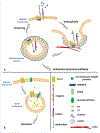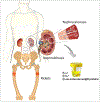From protein uptake to Dent disease: An overview of the CLCN5 gene
- PMID: 32289351
- PMCID: PMC7402612
- DOI: 10.1016/j.gene.2020.144662
From protein uptake to Dent disease: An overview of the CLCN5 gene
Abstract
Proteinuria is a well-known risk factor, not only for renal disorders, but also for several other problems such as cardiovascular diseases and overall mortality. In the kidney, the chloride channel Cl-/H+ exchanger ClC-5 encoded by the CLCN5 gene is actively involved in preventing protein loss. This action becomes evident in patients suffering from the rare proximal tubulopathy Dent disease because they carry a defective ClC-5 due to CLCN5 mutations. In fact, proteinuria is the distinctive clinical sign of Dent disease, and mainly involves the loss of low-molecular-weight proteins. The identification of CLCN5 disease-causing mutations has greatly improved our understanding of ClC-5 function and of the ClC-5-related physiological processes in the kidney. This review outlines current knowledge regarding the CLCN5 gene and its protein product, providing an update on ClC-5 function in tubular and glomerular cells, and focusing on its relationship with proteinuria and Dent disease.
Keywords: ClC-5; ClC-5 mutant proteins; Endocytosis; Kidney; Podocytes; Proximal tubular cells.
Copyright © 2020 Elsevier B.V. All rights reserved.
Conflict of interest statement
Declaration of Competing Interest The authors declare that they have no known competing financial interests or personal relationships that could have appeared to influence the work reported in this paper.
Figures





Similar articles
-
A novel CLCN5 pathogenic mutation supports Dent disease with normal endosomal acidification.Hum Mutat. 2018 Aug;39(8):1139-1149. doi: 10.1002/humu.23556. Epub 2018 Jun 4. Hum Mutat. 2018. PMID: 29791050
-
Genetic Analyses in Dent Disease and Characterization of CLCN5 Mutations in Kidney Biopsies.Int J Mol Sci. 2020 Jan 14;21(2):516. doi: 10.3390/ijms21020516. Int J Mol Sci. 2020. PMID: 31947599 Free PMC article.
-
Bone marrow transplantation improves proximal tubule dysfunction in a mouse model of Dent disease.Kidney Int. 2017 Apr;91(4):842-855. doi: 10.1016/j.kint.2016.11.016. Epub 2017 Jan 28. Kidney Int. 2017. PMID: 28143656
-
Mutation Update of the CLCN5 Gene Responsible for Dent Disease 1.Hum Mutat. 2015 Aug;36(8):743-52. doi: 10.1002/humu.22804. Epub 2015 Jun 11. Hum Mutat. 2015. PMID: 25907713 Review.
-
Genetics and phenotypic heterogeneity of Dent disease: the dark side of the moon.Hum Genet. 2021 Mar;140(3):401-421. doi: 10.1007/s00439-020-02219-2. Epub 2020 Aug 29. Hum Genet. 2021. PMID: 32860533 Free PMC article. Review.
Cited by
-
Pediatric Dent disease presenting with rickets and end-stage renal disease: case report and literature review.J Int Med Res. 2024 Sep;52(9):3000605241280048. doi: 10.1177/03000605241280048. J Int Med Res. 2024. PMID: 39327974 Free PMC article. Review.
-
4-Phenylbutyric Acid Treatment Reduces Low-Molecular-Weight Proteinuria in a Clcn5 Knock-in Mouse Model for Dent Disease-1.Int J Mol Sci. 2024 Jul 25;25(15):8110. doi: 10.3390/ijms25158110. Int J Mol Sci. 2024. PMID: 39125679 Free PMC article.
-
A retrospective study of infantile-onset Takayasu arteritis: experience from a tertiary referral center in China.Front Cardiovasc Med. 2024 Jan 31;11:1249305. doi: 10.3389/fcvm.2024.1249305. eCollection 2024. Front Cardiovasc Med. 2024. PMID: 38357518 Free PMC article.
-
CryoEM structures of the human CLC-2 voltage-gated chloride channel reveal a ball-and-chain gating mechanism.Elife. 2024 Feb 12;12:RP90648. doi: 10.7554/eLife.90648. Elife. 2024. PMID: 38345841 Free PMC article.
-
Machine Learning-Based Integrated Analysis of PANoptosis Patterns in Acute Myeloid Leukemia Reveals a Signature Predicting Survival and Immunotherapy.Int J Clin Pract. 2024 Jan 30;2024:5113990. doi: 10.1155/2024/5113990. eCollection 2024. Int J Clin Pract. 2024. PMID: 38322112 Free PMC article.
References
Publication types
MeSH terms
Substances
Grants and funding
LinkOut - more resources
Full Text Sources


